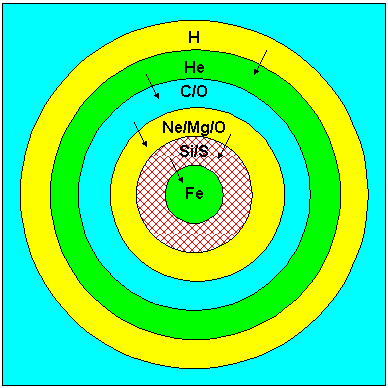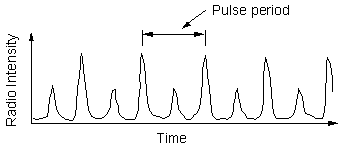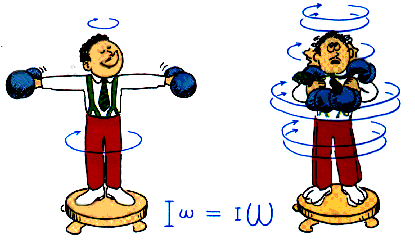Supernovae, Neutron Stars & Pulsars


| Gene Smith's Astronomy Tutorial Supernovae, Neutron Stars & Pulsars |
 |

 Following the Helium Burning Main Sequence in massive stars, a series of
nuclear burning stages transforms the
star into an onion-like shell structure, until Silicon and Sulfur
burning create a core of iron (and other iron-peak elements. During this
phase the star will criss-cross the upper regions of the H-R diagram from
Red Supergiant to Blue Supergiant and back as different core and shell
burning stages ignite. Each successive nuclear burning stage releases
less energy than the previous stage, so the lifetime in each stage becomes
progressively shorter. For a 20 M
Following the Helium Burning Main Sequence in massive stars, a series of
nuclear burning stages transforms the
star into an onion-like shell structure, until Silicon and Sulfur
burning create a core of iron (and other iron-peak elements. During this
phase the star will criss-cross the upper regions of the H-R diagram from
Red Supergiant to Blue Supergiant and back as different core and shell
burning stages ignite. Each successive nuclear burning stage releases
less energy than the previous stage, so the lifetime in each stage becomes
progressively shorter. For a 20 M star:
star:
 ) ~ 1 million
years
) ~ 1 million
years

Because iron is the most tightly bound nucleus (the "break-even point" between fusion and fission) the star is no longer able to produce energy in the core via further nuclear burning stages. Nuclear reactions will continue, however, because of the extremely high temperatures in the massive star's core. These further reactions have a devastating effect on the star, because they take energy out of the core. At such high temperatures and densities the gamma-ray photons present in the core have sufficient energy to destroy the heavy nuclei produced in the many stages of nuclear reactions, e.g.:
 + 56Fe
+ 56Fe
 134He + 4n
134He + 4n
 n +
n + 
Here is a NASA
supernova animation
of a supernova explosion and formation of a pulsar. The final death of a
massive star is a Type II supernova. As described
here there are two types of supernovae. A white dwarf star in a binary
star system may accrete material from its companion star. If the white dwarf
exceeds the 1.44M limit
for support by electron degeneracy, it will collapse and produce a Type Ia
supernova. Type I and II supernovae can be distinguished by their
light curves
and spectral emission lines. Here is some more
supernova background and further
links
here.
limit
for support by electron degeneracy, it will collapse and produce a Type Ia
supernova. Type I and II supernovae can be distinguished by their
light curves
and spectral emission lines. Here is some more
supernova background and further
links
here.
A supernova explosion may for a short period of time shine as brightly as the hundreds of billions of stars in its galaxy. Here's an example - a time series of photos of SN 1998S in the galaxy NGC 3877 taken in March--June 1998.
SN 1987A in the Large Magellanic Cloud

In February 1997 a supernova appeared near the Tarantula nebula in our satellite galaxy the Large Magellanic Cloud, about 169,000 light years away. As the first supernova discovered in 1987, it was called SN1987A following astronomical convention. SN1987A was the first "nearby" supernova of the modern era and the closest supernova since Kepler's supernova in 1604. Among the unique observations from SN1987A:
 , and an estimated
mass of about 20M
, and an estimated
mass of about 20M . An
unexpected aspect of this is that Sk -69 202 was a blue supergiant (note
temperature and spectral type) rather than a red supergiant.
. An
unexpected aspect of this is that Sk -69 202 was a blue supergiant (note
temperature and spectral type) rather than a red supergiant.
 56Co +
e+ +
56Co +
e+ +  +
+
 (6 days)
(6 days)
 56Fe +
e+ +
56Fe +
e+ +  +
+
 (79 days)
(79 days)
A supernova occurs about once per century in the Milky Way galaxy; most are obscured from our view by gas & dust, but there have been four well documented historical supernovae:
plus other probable & possible Milky Way supernovae.
According to theory, the core of the star that remains after a supernova explosion is a tiny (R ~ 10km) remnant of extremely high density neutrons, supported by neutron degeneracy -- a neutron star. The existence of Neutron Stars was predicted by Baade & Zwicky (1934) and Oppenheimer (1939). But how to detect such a small remnant?
As with many things in astronomy, the discovery came in unexpected fashion with the discovery of Pulsars. In 1967, Cambridge graduate student Jocelyn Bell (now Burnell) and her advisor, Anthony Hewish, were using a special radio telescope to look for radio scintillation, fluctuations in the signals from distant radio sources producted by turbulence in the interplanetary and interstellar plasma similar to the twinkling of stars caused by atmospheric seeing. On November 28, Bell discovered a source with an exceptionally regular pattern of radio flashes. These radio flashes occurred every 1 1/3 seconds like clockwork. Puzzled by what sort of object could produce such a regular pattern, the source was initially dubbed "LGM" - standing for little green men, because the only source that they could imagine that could be so regular was some sort of extraterrestrial technical civilization. After a few weeks, however, three more rapidly pulsating sources were detected, all with different periods. They were dubbed "pulsars."

What were the pulsars? From the short pulse duration and the rapid pulse rate, astronomers concluded that the pulsars must be exceedingly small objects. The radio pulses must come either from radial pulsations of a star, or from a rotation of a beam of light, like a lighthouse beam. Normal stars or even white dwarfs are too big to pulsate that fast, and rotation rates of several times per second would cause even the most compact stars to fly apart.
The answer to the nature of the pulsars came with the discovery of a pulsar in the direction of the Crab nebula , with a pulse rate of 30 times per second -- then the most rapid pulsar known. Continued observation of the Crab Pulsar showed that it was slowing down -- its period was increasing by 38 nanoseconds per day. This first confirmed that the pulses are produced by rotation; a pulsating object pulses only at its natural frequency. More importantly, it simultaneously solved two mysteries: the nature of pulsars and why the Crab Nebula continues to shine so brightly 1000 years after the supernova explosion.
 The Pulsar in the Crab Nebula
The Pulsar in the Crab NebulaSpinning objects have rotational energy of motion (kinetic energy)just as moving objects have translational energy of motion. A simple calculation showed that a rapidly spinning neutron star slowing down by 38 nanoseconds per day releases almost exactly the energy which is being radiated by the Crab Nebula, just the p[lace where Baade & Zwicky would predict that a neutron star might have been formed. Although the details of how the pulsar's rotational energy is transformed into the luminous energy of the nebula, this agreement was too good to be coincidence --- astronomers were certain that the elusive neutron stars had been discovered! Anthony Hewish later shared in the Nobel Prize for the discovery of pulsars.
Two conservation laws in physics suggest that it is likely that neutron stars should rotate very rapidly and should have strong magnetic fields:

The detailed mechanisms by which pulsars produce their emission from radio waves through x-rays (up even to gamma rays in some cases) is complex and not fully understood, but the basic idea --- that pulsars produce a Lighthouse Effect due to an intense magnetic field whose axis is misaligned with its rotational axis --- is generally accepted. (Remember that the earth's magnetic "North Pole" is not at the true nort pole, but in northern Canada.) One popular view is that the rapid rotation and intense magnetic field of the neutron star generate strong electric fields, which accelerate charged particles (principally electrons because they are less massive) near the magnetic poles where the magnetic field is most intense. The charged particles, accelerated along the curved magnetic field lines produce a type of light called curvature radiation. (Say in unison: "Whenever charged particles are accelerated electromagnetic radiation (light) is produced.")
Whatever the detailed mechanism, radiation near the neutron star poles produces strong, narrow beams of light which sweep around the sky like a tilted lighthouse, as shown below. If the earth lies in the path of the beam we see a pulsar. (This idea has the added attraction that it explains why we don't see pulsars in all supernova remnants.)

Energy is transported from the spinning neutron star into the nebula by the magnetic field. HST has provided dramatic evidence of the interaction of the Crab Pulsar and the supernova remnant. This Picture of the Day and this HST Press release show the ripples produced by the pulsar moving outward through the nebula, also shown in this MPEG movie.
Here is an excellent and detailed Introduction to Neutron Stars by Cole Miller at Chicago.
Listen to the sounds of pulsars from the Princeton Pulsar Group and also at England's Jodrell Bank Radio Observatory (includes Crab Pulsar).
Pulsars are frequently in the news because of their extreme nature and the wide variety of physical processes that may be studied in them. Here's a selection of recent news articles:
| Summary: End Points of Stellar Evolution | ||||||
|---|---|---|---|---|---|---|
| Remnant | Progenitor Mass |
Remnant Mass |
Size | Density | Means of Support |
Final Stage |
| White Dwarf | M* < 8M |
MWD < 1.4M
|
RWD ~ Rearth | 1 ton/cm3 (1 Volkswagen/cm3) |
e- degeneracy | Planetary Nebula |
| Neutron Star | 8M < M* <
20M < M* <
20M |
MNS < 3M
|
RNS ~ 10 km | 200 million ton/cm3 (All Volkswagens/cm3) |
n degeneracy | Supernova |
| Black Hole | M* > 20M
|
MBH > 3M
|
0 Rgrav = 2GM/c2 |
 |
none | ? |

![]() General Relativity & Black Holes
General Relativity & Black Holes
![]() Stellar Evolution #2
Stellar Evolution #2
![]() Education & Outreach
Education & Outreach
![]() CASS Home
CASS Home
Conducted by Gene Smith, CASS/UCSD.
Comments?
You may send email to hsmith@ucsd.edu
Prof. H. E. (Gene) Smith
CASS 0424 UCSD
9500 Gilman Drive
La Jolla, CA 92093-0424
Last updated: 16 April 1999